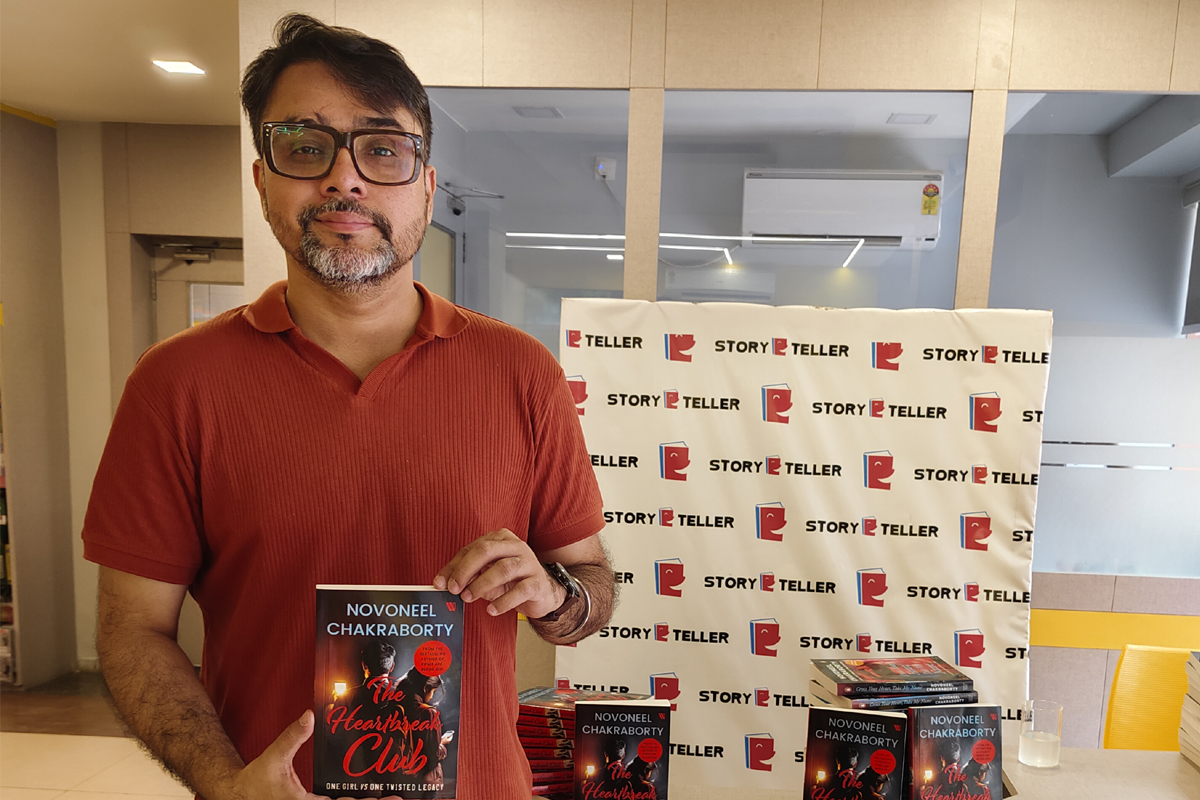Step right up, folks, for Novoneel Chakraborty’s latest roller-coaster ride, The Heartbreak Club! In this book, you’ll meet Kisha Sen, the fearless newcomer at Fairmont High International School, who’s not just turning heads but stirring up trouble. With her sister gone missing and suspicions pointing to the elusive Heartbreak Club, Kisha dives headfirst into the murky waters of high school drama. But watch out, because this club isn’t just gossip and giggles—it’s a powerhouse of chaos, and Kisha is on a collision course with danger. Get ready for a wild ride through passion, lies and sweet revenge as Chakraborty weaves a tale of sisterly love and unyielding determination against all odds.
In an engaging tête-à-tête with The Statesman within the cosy confines of the Storyteller Bookstore in Kolkata, author Novoneel Chakraborty speaks about the complexities of his literary creations, illuminating characters that populate his books.
Advertisement
Excerpts are as follows:
Advertisement
Q. What inspired you to write The Heartbreak Club? Was there a particular event or idea that sparked the storyline?
I decided to take a break from writing crime thrillers and explore a new genre – high school thrillers. I realised there weren’t many such stories in India, especially in English. So, I saw it as an exciting challenge to dive into this unexplored territory. My previous works like the Forever series, Half Torn Hearts and Ex:A Twisted Love Story briefly touched on high school settings. So, the challenge of capturing the thoughts and reactions of 15-16-year-olds was creatively stimulating. As I brainstormed, I pondered on what unique element I could bring to the genre. Recalling my own school days, I thought about the various clubs we had – music, sports, drama, etc. Then it struck me – what if there was a secret club with its own agenda, known only to a select few students? This club would have a legacy, with members coming and going over time. Placing my protagonist, Kisha, against this club created an intriguing conflict between her goals and the established legacy. The disappearance of her elder sister added depth to her character arc. And thus, the idea for my high school thriller was born, merging suspense with the zest of teenage life.
Q. The book explores the concept of power dynamics within groups like the Heartbreak Club. Can you discuss how you portrayed this theme and its relevance in contemporary society?
While the book primarily focuses on school dynamics and student life, it subtly reflects broader societal power dynamics. In today’s times, everything seems divided into verticals, leading to inherent power struggles at various levels – cultural, societal, and corporate. The club in the book symbolically represents entrenched beliefs that are unquestioned and accepted without challenge. The protagonist’s journey involves questioning these norms, leading to the dismantling of the club in the second part of the series. The narrative encourages readers to challenge conditioned acceptance and embrace critical thinking for societal progress. While my main goal is to entertain with thrilling stories, the subtextual commentary on power dynamics adds depth for those who wish to explore it.
Q. Your novels often feature morally ambiguous characters. How do you approach character development to make these characters relatable yet complex?
I believe that everyone has a degree of moral ambiguity, though some may not be aware of it until faced with challenging situations. It’s about navigating through situations where moral choices are not always clear-cut. This doesn’t necessarily mean being negative; one can have moral complexity yet choose the right path. In storytelling, the essence of drama often lies in exploring ambiguity – be it moral, emotional, or physical. Art serves the purpose of unravelling complexities and allowing individuals to draw their own interpretations and answers. If everything were straightforward, storytelling would lose its essence of reflecting real-life dilemmas and human psychology. I find intrigue in characters who are morally grey and unpredictable, as they offer depth and complexity to narratives. Exploring human psychology and the different facets of personalities excites me as a storyteller, shaping my preference for morally ambiguous characters in my works.
Q. Your books are known for being thrilling with a story within a story, blending elements of crime and romance. How do you manage to incorporate these intricate details without risking the story becoming monotonous for readers?
In my writing career, I’ve always delved into mixed genres, blending relationship dramas with elements of thrillers and crime. While marketing often necessitates labelling books under specific genres for reader understanding, my novels typically encompass a variety of themes and genres. Maintaining reader engagement and avoiding boredom is a key aspect of crafting gripping narratives. I ensure that every few pages reveal new and intriguing plot points or character developments, keeping the story fresh and readers invested. This approach mimics the excitement of discovering new tricks in a magic show – it’s about consistently offering surprises and twists that fit organically within the narrative. By infusing these ‘bends in the road’ at regular intervals, I strive to create unputdownable books that keep readers on the edge of their seats. Additionally, I rely on my own restlessness as a reader to guide the pacing of the story, constantly revisiting and refining the narrative to maintain its momentum and intrigue. Overall, writing a gripping thriller involves a continuous process of experimentation and refinement.
Q. Can you discuss any specific challenges you faced while writing The Heartbreak Club, especially in terms of plot intricacies or character arcs?
The biggest challenge I faced was getting into the head of a 16-year-old in today’s time. Understanding their reactions and behaviour required more than just reading about adolescence in books or media; it involved real-world observation. I would observe teenagers in public spaces, noting how they interacted, their body language, and the topics they discussed. For instance, I once overheard a group of schoolgirls in a café having candid discussions about topics which were considered ‘taboo’ back in the day. These observations helped shape authentic teenage characters in my book. It was crucial to capture the essence of being a teenager without alienating actual teenagers who would read the book. While some teens may display maturity, it’s essential to reflect their worldview accurately, which often includes a mix of naivety and insight unique to their age.
Q. Your books often feature strong female protagonists. What draws you to sketch such characters?
I’ve been asked this question many times, and while I’ve given answers before, I honestly don’t know why I consistently choose female perspectives for my books. Whether it’s a 30-year-old woman, a 16-year-old girl like in The Heartbreak Club, or the two girls in my upcoming book, it just fascinates me. Maybe it’s because women offer complex layers that intrigue me more than male characters. I believe there’s a subconscious element at play here, although I can’t pinpoint it exactly. What excites me is probing into mysteries through a female lens, where strength is inherent. While they may experience moments of vulnerability since weakness is a natural part of being human and not a defining trait, they ultimately come into their own. It has become my creative comfort zone, shaping the narratives in my stories. This perspective has become my creative comfort zone, though I don’t have a specific answer as to why.
Q. Your works have garnered a wide readership across different age groups. How do you think your storytelling appeals to such diverse audiences, and do you tailor your writing style accordingly?
I don’t consciously consider age brackets like 16, 26 or 36 when writing because they represent different generations and perspectives. Trying to cater to all these age groups simultaneously is impossible as their experiences and understanding vary greatly. Instead, I trust my instincts and let the story unfold naturally. Universal truths in the story resonate with readers across age groups, making it relatable beyond target demographics. Art, including writing, is open to interpretation, and readers bring their unique experiences to the narrative. I focus on creating authentic stories rather than overthinking audience segmentation, allowing readers to derive their own meaning from the work.
Q. Several of your works have been adapted for screen adaptations. How does your storytelling approach differ when writing for different mediums?
Adapting a book into a screenplay is a distinct craft, and unfortunately, in India, there’s a lack of expertise in this area. Many people don’t grasp the essence of storytelling or understand the nuances of transforming a novel into a screenplay effectively. It’s been a personal challenge for me as well. While I’ve worked on screen adaptations of my books, the collaborative nature of the process can be frustrating. Sometimes, my vision clashes with others’ interpretations, resulting in mixed outcomes. However, when given the freedom, I enjoy the creative aspect.
Q. Can you tease any upcoming projects or ideas you’re currently working on that fans can look forward to?
Part two of The Heartbreak Club is in the works, although there’s no fixed release date yet. Ideally, we are aiming for a November release this year, but it’s not confirmed. The gap between books is crucial to build anticipation and ensure a sizable audience for the sequel. Currently, we are assessing the response to the first book, and planning accordingly for the second instalment, giving it about six to eight months before its release.
Q. What message or emotion do you hope readers take away from The Heartbreak Club?
This question presents another challenge because readers will interpret the book in their own way. However, what I hope they take away is the resilience of the protagonist, emphasising that no matter how daunting life’s challenges may seem, solutions are always within reach through decisive action. Life is a series of choices, whether to confront problems head-on or succumb to them, ultimately shaping our destinies. Additionally, the book advocates for embracing failure as an integral part of personal growth. Society often stigmatises failure, yet it is through setbacks that we learn and evolve the most. Celebrating failures, especially in youth, teaches invaluable lessons in resilience and determination. While readers may derive various interpretations from the story, I hope these themes resonate with them alongside the narrative.
Advertisement











